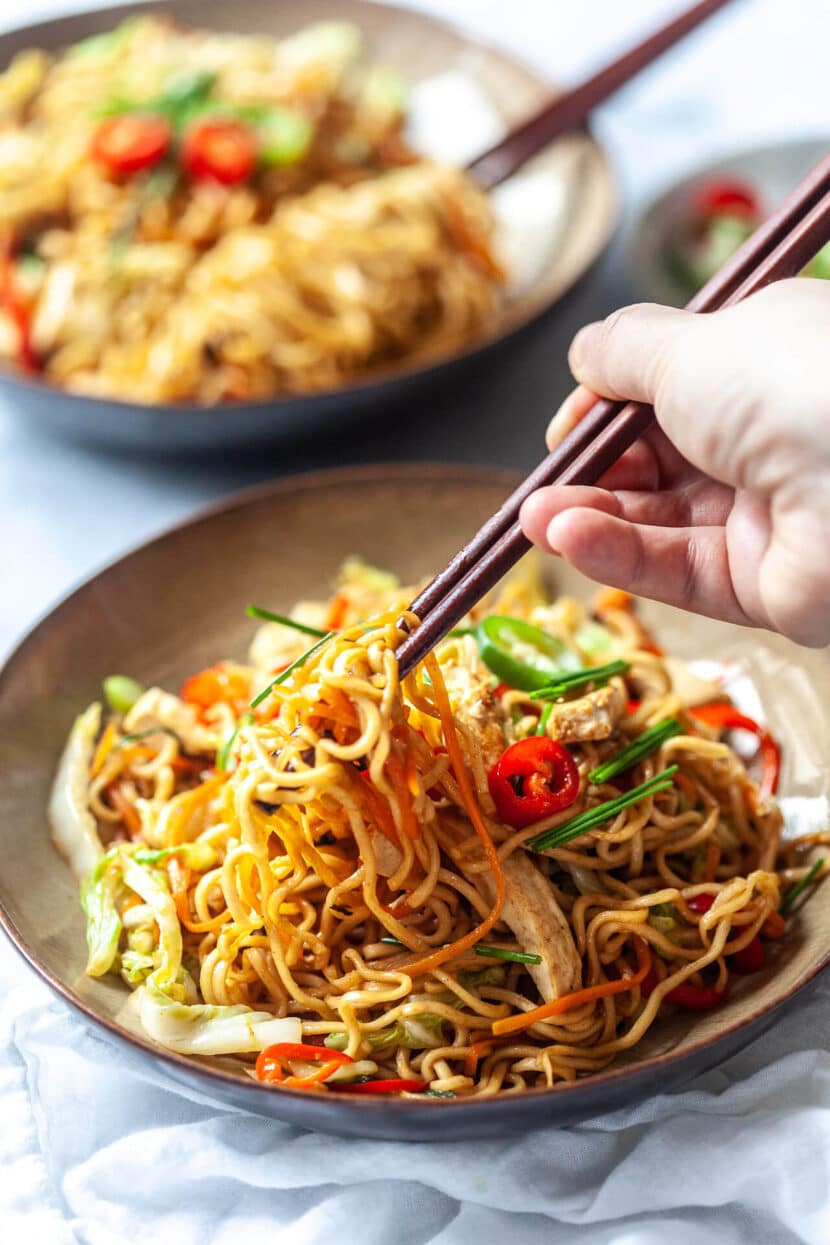The easiest Vegan Tofu Lo Mein Recipe to make in minutes for your weeknight’s dinner. Vegan & Meal-Prep friendly.
We’re coming to you today with our perhaps most requested recipe from Instagram Stories – the Vegan Tofu Lo Mein Recipe!
We’ve been making this dish regularly for forever, and yet it never made its way to the blog before! We don’t know how that ever happened (and we apologize for making you wait this long), but we’re fixing it and sharing all our tips and tricks to make the perfect, most delicious, and easy Lo Mein at home.
Ready?
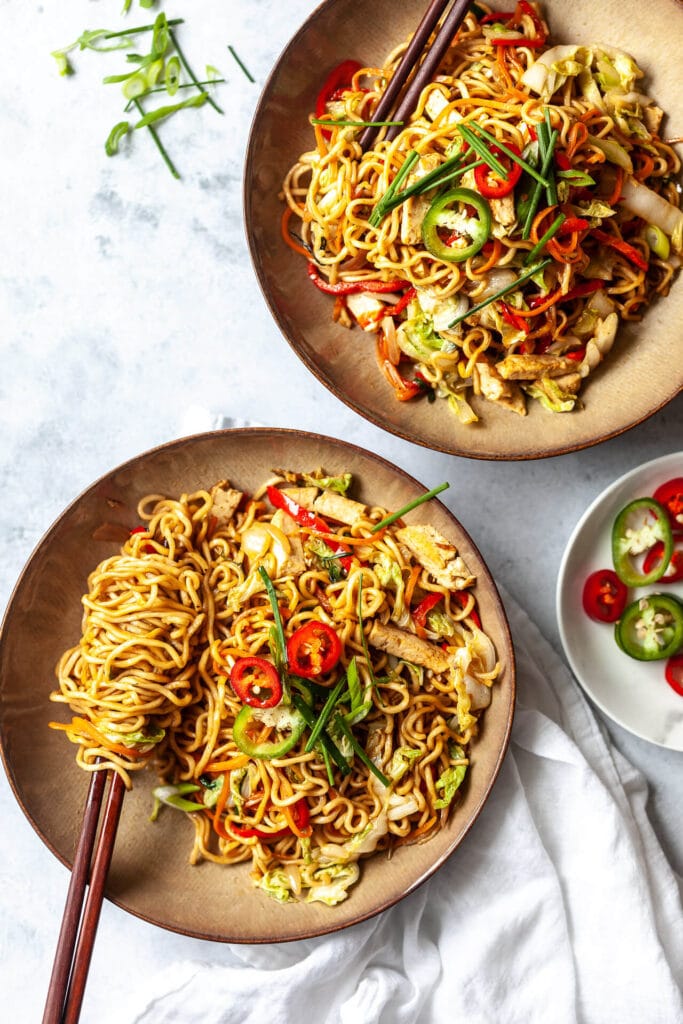
What is Lo Mein
Lo Mein noodles are a traditional Chinese dish of egg noodles and it means “stirred noodles”. You stir the cooked noodles in the wok along with some protein and/or vegetables.
In this recipe, we went for a fully plant-based option, so we used noodles that don’t contain eggs, and chose tofu as our protein source.
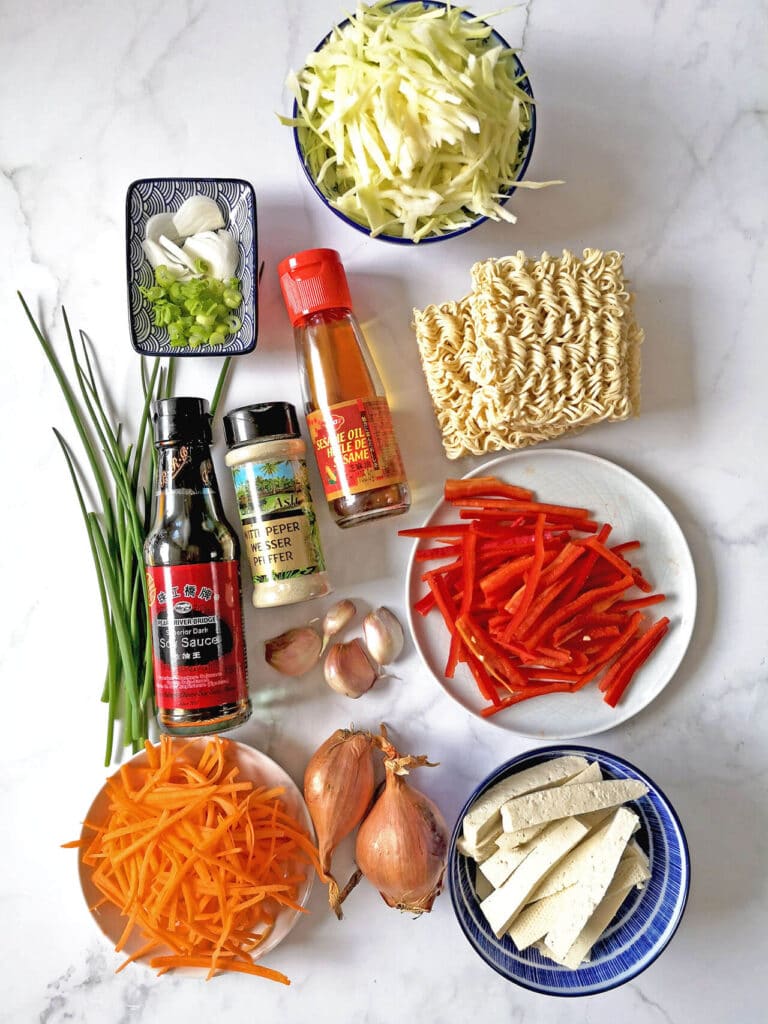
Ingredients & Subsitutions
Here are all the ingredients you will need to make this dish:
- firm tofu – Use nice firm tofu that will not break apart when stir-frying. We like a natural flavored one (that is with no extra flavors), which we then season to taste. If your tofu is watery, try pressing it first for half an hour by placing a heavy pot on it, before use.
- salt – use sparingly, just to season the tofu, as soy sauce is also quite salty.
- white pepper – we find white pepper ads a more authentic Asian flavor to the dish, so we recommend using it, but black pepper will also work just as well.
- vegetable oil
- shallots – onions superior cousin, use shallots for cooking Asian dishes to get a more authentic taste. If you do not have shallots, regular onion is ok, too.
- garlic – no substitutions, garlic is a must and the king of flavors
- carrot – we like to slice it really thin (julienne) by using a julienne peeler
- red pepper – red pepper is the ripest of the peppers so higher in sugars and will caramelize really nice while stir-frying. If you don’t have a red pepper, other peppers are also fine. If you like your Lo Mein spicy, add chili peppers as well (to taste)
- napa cabbage – work really when stir-frying and will add more vegetables to your dish. If you don’t have napa cabbage, you can substitute with regular cabbage or even purple cabbage (fair warning, purple cabbage may turn your dish a blue-ish hint, so use acid to counteract it, like a squeeze of lime juice)
- spring onions
- chives – this is totally optional, but we use fresh chives in this recipe to add a bit of a fresh garlicky taste. If you have garlic chives it works even better.
- ramen noodles – We like to stir fry using cooked ramen noodles, but you can use other noodles as well, such as spaghetti, or even rice noodles to keep this dish gluten-free.
- soy sauce – we use a combination of light and dark soy sauce to get the best results. Don’t skip soy sauce, but to keep this dish gluten-free, choose a gluten-free variety.
- sesame oil – ok, this is the secret ingredient! When your noodles are done, drizzle them with a bit of sesame oil for the best authentic flavors and the taste of your take-out! If you don’t have sesame oil, you can skip it, or use peanut oil or other plain vegetables oil (but not olive oil).
What vegetables can I use?
To make a delicious noodle stir fry you can use just about any vegetables you want! So if you don’t have (or don’t like) red peppers, or cabbage, you can also use other vegetables. Broccoli would work really well, as well as bean sprouts, snow peas, zucchini, or mushrooms. Some vegetables can be even used from frozen.
What protein can I use?
This recipe uses tofu as the protein source and works best for a vegan version.
If you are vegetarian, you can also add an egg or two while stir-frying and it will make the noodles extra rich and nutritious.
Omnivores can use chicken instead of tofu, or just use tofu as intended, tofu is good for you.
What noodles work best
We like to use ramen noodles or mie noodles in this recipe, but you can also use plain spaghetti or – to keep this dish gluten-free – rice noodles. Just adjust cooking time accordingly (see instructions on your package) and keep the noodles slightly undercooked, as we will continue to cook them in the wok.
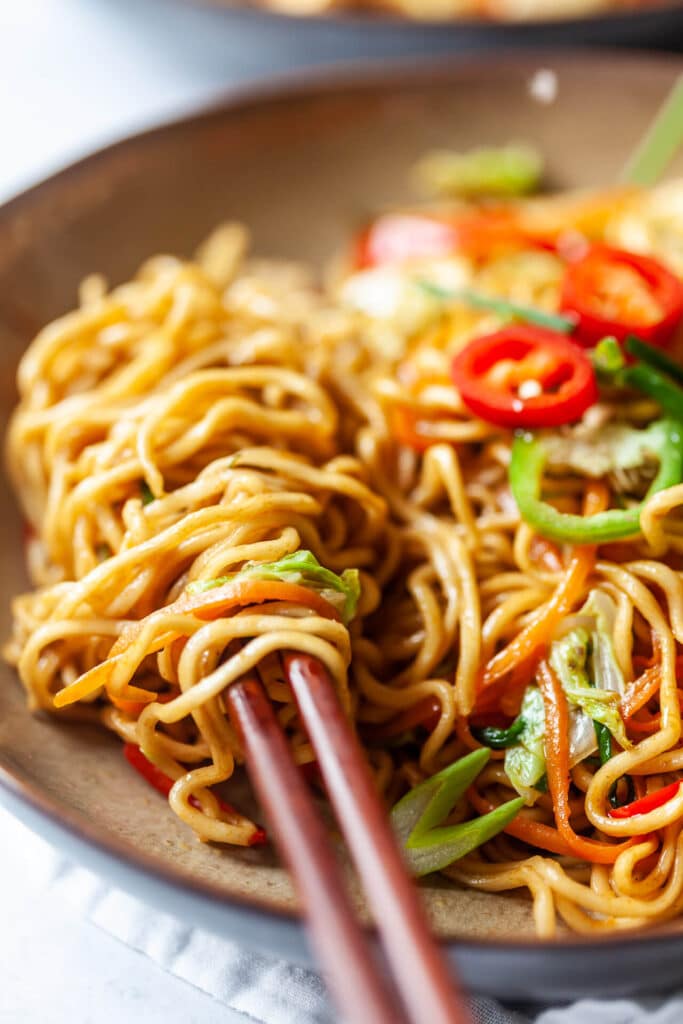
How to make this Vegan Tofu Lo Mein
Always when stir-frying, prep your ingredients first (mise en place) and have them ready to go before you start cooking.
So, slice the tofu and season it with salt and white pepper. Slice shallots and mince your garlic. Julienne your carrots and peppers. Slice your cabbage, spring onions, and chives.
In a pot, bring water to a boil, season with salt, and add the noodles. Cook them according to package instructions, then drain, cool down, drizzle with oil, and set aside. You could also make this a day ahead if you wanted, but it comes together really quickly.
Next, heat your wok (or a large pan), add a drizzle of vegetable oil, then toss in the napa cabbage, spring onions, and chives. Season with a sprinkle of salt and white pepper and stir-fry, until the cabbage starts charring – this will add a smoky flavor to the final dish. Remove from pan and set aside.
To the same wok, add the marinated tofu with shallots and garlic. Stir-fry for a minute or two, until the tofu starts to turn golden-brown and the shallots soften, then remove from the wok and set aside.
Now toss in the carrots and red pepper, and stir-fry until the vegetables start softening and the peppers start charring. If your wok looks dry, add a drizzle of oil.
Lastly, combine all your ingredients in the wok: add the cooked noodles, tofu, and cabbage. Toss to combine everything Drizzle with soy sauce and sesame oil and toss again.
That’s it!
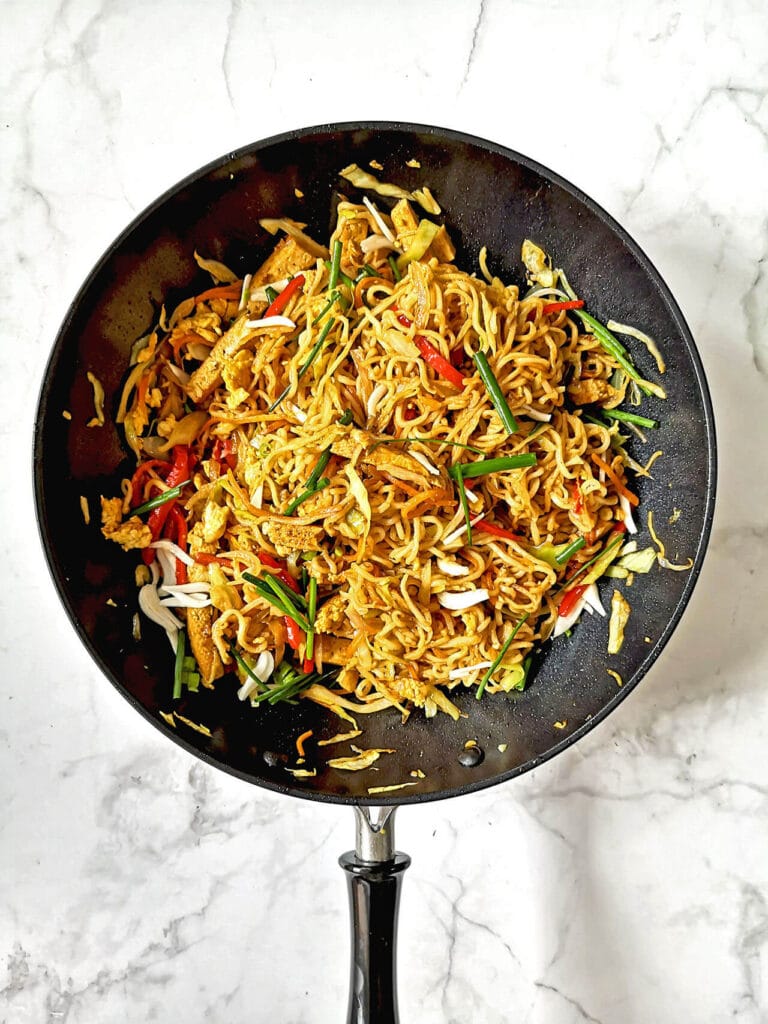
Serving
We like to serve these Vegan Tofu Lo Mein noodles with a sprinkle of chopped spring onions and chives for extra crunch and flavor. If you like your lo mein spicy, add some chili slices.
You can serve this dish hot from the wok, but it also works if you just pull your container from the fridge and eat it cold.
Storage
You can make these noodles as part of your meal-prep plan, as they keep really well! Store them refrigerated in an air-tight container for up to 3 days.
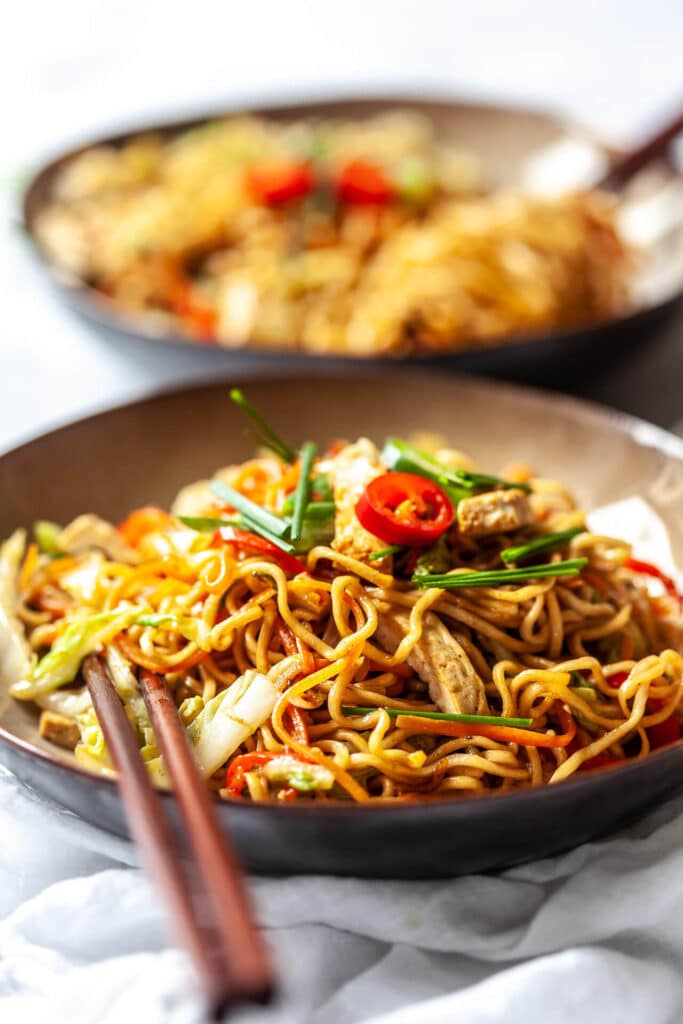
Tips to making the best Vegan Lo Mein
There are a couple of tricks I learned in my years of making this dish:
- slice your vegetables thinly. This will help cook them really fast, in just minutes, plus it will have a nice bite when eating. I generally aim to make the vegetable slices as thin as the noodles, but cabbage can be sliced bigger if it’s tender and young.
- do not overcook. Stir-frying is fast, on high heat, and the end result should make for vegetables and noodles that are softened, but still have some bite to them. Also, take care to not overcook your noodles, as they will turn to mush and you will end up having a sad, gloopy pile of mush instead of the perfect Lo Mein noodles.
- do not fear the soy sauce. Yes, it’s a bit salty, but it will add greatly to the flavor of the dish and keep it moist. You don’t want dry noodles. If you are worried about the salt content, you can find low-sodium soy sauces. Also, use light soy sauce and dark soy sauce for the best results.
- finish with sesame oil. Seriously, get yourself a small bottle of authentic sesame oil from your Asian store (see ingredient picture) and add just a drizzle on top when you’re done cooking. Do not use the sesame oil to stir-fry in, but just to finish the dish. It will add greatly to the final flavor. Real sesame oil has a reddish tint to the color and a sharp smell and it’s the best thing ever for Asian dishes.
- top with an uncooked garnish – try chopped spring onion, some garlic chives, or fresh bean sprouts. All will add a fresh accent and a crunch to the final perfect bite.
If you have any other questions about this dish, feel free to leave us a comment and we’ll get back to you with an answer!
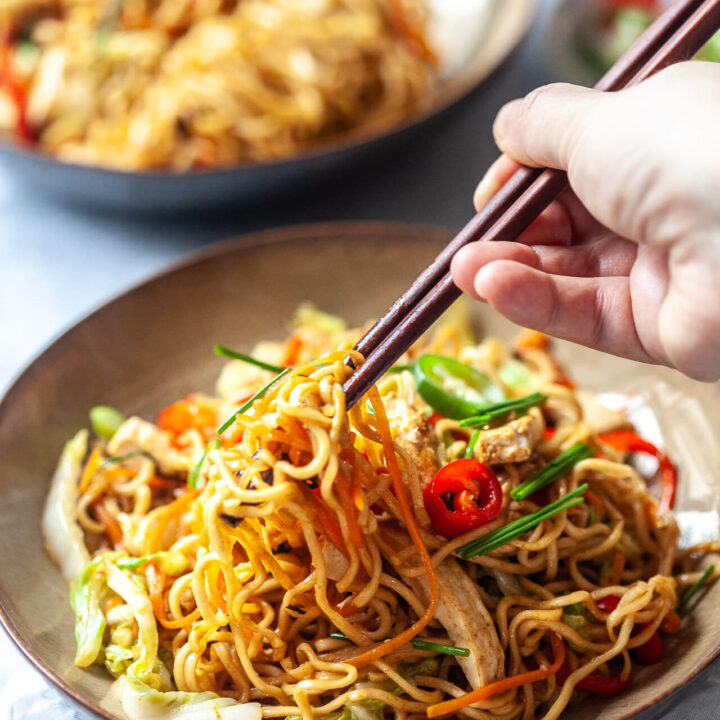
Vegan Tofu Lo Mein
The easiest Vegan Tofu Lo Mein Recipe to make in minutes for your weeknight's dinner. Vegan & Meal-Prep Friendly.
Ingredients
- 200 grams firm tofu, plain
- pinch of salt
- white pepper to taste
- 2 tbsp vegetable oil
- 1-2 shallots
- 4 cloves garlic
- 1 carrot, medium-sized
- 1 red pepper
- 2 cups napa cabbage
- 2 spring onions
- chives (optional)
- 200 grams ramen noodles
- 1 tbsp soy sauce
- ½ tbsp dark soy sauce
- 2 tsp sesame oil
Instructions
- Prep your ingredients, so they are ready to go: slice 200 grams tofu, season it with salt and white pepper, and a drizzle of oil. Slice 1-2 shallots and mince 3-4 cloves of garlic. Cut 1 carrot and 1 red pepper into thin strips (julienne). Cut 2 cups of cabbage. Thinly slice spring onion and chives.
- In a pot of salted water cook 200 grams of ramen noodles according to package instructions. Once cooked, drain the noodles, run them under cold water to cool them down, then drizzle with vegetable oil and mix to combine. Set aside.
- Start cooking: heat a large pan or wok, add a drizzle of vegetable oil, then toss in the napa cabbage along with spring onions and chives. Season with a sprinkle of salt and white pepper and stir-fry, until the cabbage is wilted and starts charring. Remove from pan and set aside.
- To the wok, now add the marinated tofu with shallots and garlic. Stir-fry for a minute or two, until the tofu starts to turn golden-brown and the shallots soften, then remove from the wok and set aside.
- If needed, add another drizzle of oil to the wok, then toss in the sliced carrots and red pepper. Stir-fry until the vegetables start softening.
- Now add the cooked ramen noodles, toss to combine, then return the tofu and cabbage to the wok. Season with 1 tbsp soy sauce, ½ tbsp dark soy sauce, and 2 tsp sesame oil and toss to combine.
- Serve hot.
Notes
Optionally, add chilis for spice.
For extra flavor, season the tofu with a grilled chicken spice mix – there is no chicken in it and it is vegan, but it will add a ton of flavor to your tofu.
if you are vegetarian, add in a fried egg for extra protein
Nutrition Information:
Yield: 3 Serving Size: 1Amount Per Serving: Calories: 268Total Fat: 18gSaturated Fat: 3gTrans Fat: 0gUnsaturated Fat: 14gCholesterol: 0mgSodium: 702mgCarbohydrates: 20gFiber: 4gSugar: 5gProtein: 11g
Nutrition data is automatically calculated using Nutritionix and may not be accurate.
If you like this recipe, you can let us know in the comments below or on social media using #vibrantplate and tag us @vibrantplate. We’re always happy to read your feedback and LOVE seeing your take on our recipes.
Also, find more Asian-inspired recipes here!
You can connect with us on our Instagram, Facebook, or Pinterest. We share many behind-the-scenes photos and step-by-step recipes in our Instagram Stories, so be sure to check it out!

